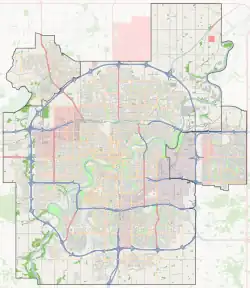Argyll, Edmonton
Argyll is a residential neighbourhood in Edmonton, Alberta, Canada, located on the south side of the city between the two branches of the Mill Creek Ravine. It is bounded by the ravine on the west and north east sides, and by Argyll Road on the south and south east sides. On the other side of Mill Creek Ravine are the residential neighbourhoods of Avonmore and Hazeldean. On the other side of Argyll Road is the industrial subdivision of Coronet Addition Industrial. The Argyll Sports Centre is located in the neighbourhood.
Argyll | |
|---|---|
Neighbourhood | |
 Argyll Location of Argyll in Edmonton | |
| Coordinates: 53.503°N 113.460°W | |
| Country | |
| Province | |
| City | Edmonton |
| Quadrant[1] | NW |
| Ward[1] | papastew |
| Sector[2] | Mature area |
| Government | |
| • Mayor | Amarjeet Sohi |
| • Administrative body | Edmonton City Council |
| • Councillor | Michael Janz |
| Area | |
| • Total | 0.36 km2 (0.14 sq mi) |
| Elevation | 673 m (2,208 ft) |
| Population (2012)[5] | |
| • Total | 853 |
| • Density | 2,369.4/km2 (6,137/sq mi) |
| • Change (2009–12) | |
| • Dwellings | 354 |
Most residential construction (93%) in the neighbourhood occurred between the end of World War II and 1970. Almost all the residences in the neighbourhood are single-family dwellings. The majority (83%) of residences are owner-occupied.[6]
The community is represented by the Argyll community league, established in 1956, which maintains a community hall at 67 Avenue and 88 Street.[7][8]
Demographics
In the City of Edmonton's 2012 municipal census, Argyll had a population of 853 living in 354 dwellings,[5] a 5% change from its 2009 population of 812.[9] With a land area of 0.36 km2 (0.14 sq mi),[4] it had a population density of 2,369.4 people/km2 in 2012.[5][4]
Household income for Argyll is close to the average for the City of Edmonton.
| Income Range ($) | Argyll[12] | Edmonton[13] |
|---|---|---|
| (% of Households) | (% of Households) | |
| Under $10,000 | 0.0% | 6.3% |
| $10,000–$19,999 | 6.5% | 12.4% |
| $20,000–$29,999 | 14.5% | 11.9% |
| $30,000–$39,999 | 3.2% | 11.8% |
| $40,000–$49,999 | 16.1% | 10.9% |
| $50,000–$59,999 | 11.3% | 9.5% |
| $60,000–$69,999 | 16.1% | 8.3% |
| $70,000–$79,999 | 9.6% | 6.7% |
| $80,000–$89,999 | 8.1% | 5.4% |
| $90,000–$99,999 | 8.1% | 4.2%% |
| $100,000 and over | 6.5% | 12.6%% |
| Average household income | $59,398 | $57,360 |
References
- "City of Edmonton Wards & Standard Neighbourhoods" (PDF). City of Edmonton. Archived from the original (PDF) on May 3, 2014. Retrieved February 13, 2013.
- "Edmonton Developing and Planned Neighbourhoods, 2011" (PDF). City of Edmonton. Archived from the original (PDF) on September 4, 2013. Retrieved February 13, 2013.
- "City Councillors". City of Edmonton. Retrieved February 16, 2014.
- "Neighbourhoods (data plus kml file)". City of Edmonton. Retrieved February 13, 2013.
- "Municipal Census Results – Edmonton 2012 Census". City of Edmonton. Retrieved February 22, 2013.
- and
- "Argyll Community League". Argyll Community League. Archived from the original on March 26, 2017. Retrieved October 7, 2017.
- Kuban, Ron (2005). Edmonton's Urban Villages: The Community League Movement. University of Alberta Press. ISBN 9781459303249.
- "2009 Municipal Census Results". City of Edmonton. Retrieved February 22, 2013.
- 2000 dollars
- Income is for all persons in the household. So, if there are two persons in the household and each person earns $15,000, the household income is $30,000
- "Argyll - 2001 Federal Census Income by Households In 2000 Dollars" (PDF). City of Edmonton. 2001.
- "Edmonton - 2001 Federal Census Income by Households In 2000 Dollars" (PDF). City of Edmonton. 2001.